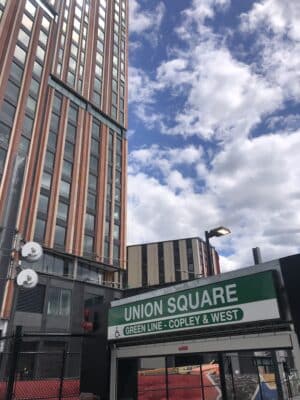
Developer US2 says it plans to bring in local, as well as national credit tenants as it reimagines one of Somerville’s major neighborhoods. Photo by Steve Adams | Banker & Tradesman Staff
A double-edged sword can swing through a neighborhood when long-desired transit connectivity finally rolls in.
While a new subway or light rail station brings better, more-frequent access to the city, it often ushers in higher rents that displace longtime residents and small retail tenants. The Metropolitan Area Planning Council warned nearly a decade ago about the risk of displacement that would arrive with the Green Line Extension into Somerville.
But the largest developer active in the city’s Union Square claims they want to alleviate that risk factor on the retail side of the equation.
“Early on in the development phase, one of the challenges we consistently heard from small businesses located in Union Square was there was not enough daytime foot traffic in the neighborhood,” said Greg Karczewski, president of US2, developer of the planned 2.7 million-square-foot mixed-use USQ project. “Within our daily approach to development, USQ works very closely with small businesses and the organizations that support them. We want to ensure businesses within the Square, not just within USQ’s footprint, benefit from new patrons.”
‘Meaningful’ Foot Traffic Sought
USQ plans to include 140,000 square feet of retail in the development, and it’s natural all eyes are on how this development knits into the surrounding Union Square neighborhood. The first phase of the overall USQ project includes 450 residences and a 7-story lab building. This three-tower first phase at 10-50 Prospect St. will include ground-floor retail.
Karczewski said the USQ development team is working to offer space to a mix of national and local retailers – complementing the likes of nearby Bow Market, an arcade of independent eateries and boutique retailers, rather than displacing it. The developer noted a variety of ways his firm is supporting local businesses amid the construction boom in the area.
US2 has supported Bow Market Small Business Saturday for two years and provided support to the Union Square Main Streets community development organization since 2015, Karczewski said.
“The opening of the [Green Line Extension], which we collaborated on closely with the MBTA and city of Somerville, has already significantly increased foot traffic, and the upcoming openings of 10-50 Prospect St. will continue to create meaningful foot traffic that benefits all businesses,” he added.
It might be the kind of thing any developer would say in defending their push into an established neighborhood.
But analysts don’t necessarily see immediate warnings signs of mom-and-pop retailers in Union Square getting scuppered by rising rents in favor of a mix of bank branches and other symbols of gentrification. Instead, it’s hoped these business will find ways to successfully court the new transit access and development activity to improve their bottom lines.
“If you want to have a good retail node with businesses that are thriving and growing and expanding, there’s a couple of different things that you typically want to look for,” said Jeffrey Myers, research director at commercial brokerage Colliers. “Number-one is population, and what we see in this neighborhood is that there are more people moving in, and that a lot of the households moving in are relatively affluent. So, dollars times bodies equal retail sales [and] equals restaurant sales, and those are all good things.”

Developer US2 points to its support for local business groups and the foot traffic its developments will bring to Union Square as evidence its projects will benefit existing local businesses. Photo by Steve Adams | Banker & Tradesman Staff
Pressure to Tailor Brand Offerings
The surge in affluent residents to new developments coupled with developers usually seeking credit-worthy tenants, often national chains, for ground-level retail usually means there aren’t many local retailers in new shopping districts. This retail critique dogged Boston’s Seaport District in its early phases of development.
But Union Square’s more established retailers – Union Square Donuts might be everywhere these days, but its original location remains standing in its eponymous neighborhood – and its shopping reputation means it’s harder for developers to woo residents with shopping you can find anywhere.
Union Square Donuts and Bow Market retailers coexist with Dunkin Donuts and big-box stores like Market Basket and even a Target mere blocks from the new Green Line station.
“In the Boston area, there are tons of squares. Most of them don’t have the magnitude of existing retail that Union Square does. There’s a gravity there, so [it’s] not starting from scratch,” Myers said. “You do get a mixture of the national and the local retailers in Union Square in a way that you don’t get in a lot of other squares in the Boston area.”
Reliable retail data is harder to track than office rents, but anecdotal evidence gives Myers reason to see Union Square’s retail future having more runway for growth rather than a bleak future of elbowing out local shops.
There’s a farmers’ market, seasonal festivals, restaurants, bars and more day-to-day services like a barber shop already within the borders of Union Square – and they’ve all survived despite competition from nearby, big-box national brands.
“This is really becoming a neighborhood serving and starting to expand to maybe more of a wider Somerville, Cambridge or slight regional area given the growth that’s taking place there,” Myers said. “Given the more residential units and more jobs coming to the area, Union Square retail has upside moving forward.”





